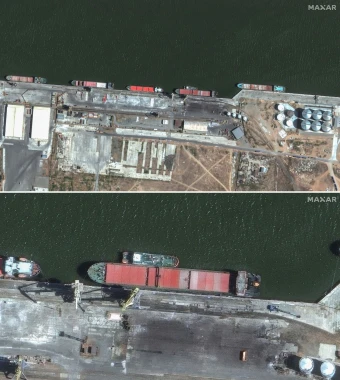
Iran’s Fath-360 missile shipment to Russia: route, dates, numbers revealed
The recent delivery of Iranian Fath-360 ballistic missiles to Russia may be just the first of many
Sky News reports, citing satellite images and Ukrainian intelligence, that the Iran's missiles arrived in Russia on September 4. The shipment, which included 220 Fath-360 missiles, was transported by the Port Olya ship, which had been in the Iranian port of Amirabad on August 29.

The Russian vessel had turned off its transponder to avoid detection. After arriving in Russian Astrakhan, the missiles were unloaded and transported by rail to the Ashuluk training ground.
This suggests that future deliveries of Fath-360 missiles via this route could become a regular occurrence, Sky News adds.
Defense Express media and consulting company reports that the Ashuluk training ground, located about 100 kilometers north of Astrakhan, is used for anti-aircraft gunners training and testing air defense systems. However, it was recently utilized to fire a number of Fath-360 missiles to evaluate their performance.
“The timeline of events aligns with reports from August 10, which came from an unnamed intelligence agency and mentioned that the transfer of Iranian-made missiles to Russia was in its 'final stages.' Subsequent details emerged, leading to official confirmations from Washington about the transfer. This suggests that Western intelligence has closely monitored the transfer of Fath-360 missiles,” Defense Express reported.
Media and consulting company notes that the 220 Fath-360 missiles mentioned are likely just one batch and do not represent the total number that may be transferred to Russia. Information about the transfer of launchers is also lacking, though they might have been produced in Russia or delivered by air. According to unconfirmed reports, an agreement for the missile transfer was made in December 2023.
The Fath-360 is a missile with a range of 120 km, weighs 787 kg, and has a warhead weighing approximately 150 kg. It uses an inertial guidance system with satellite navigation. Iran typically launches these missiles using a 6x6 truck chassis equipped with 6 launchers.
Iran's missile deliveries to Russia
Earlier, British military analyst Sean Bell warned that Russia would soon receive two types of ballistic missiles from Iran and that it was "inevitable."
On September 6, the U.S. informed its allies that Iran had sent ballistic missiles to Russia. The United States and Europe are working on sanctions in response to Tehran's actions.
A report by the Institute for the Study of War (ISW) states that after transferring hundreds of short-range ballistic missiles to Russia to support the war against Ukraine, Iran expects to receive Russian Su-35 fighter jets.
On September 7, the Ministry of Foreign Affairs of Ukraine expressed deep concern over reports of Iran's possible transfer of ballistic missiles to Russia.
On September 8, Iran denied reports of ballistic missile supplies to Russia, claiming that it does not provide military support to any of the parties in Russia's war against Ukraine.
On September 9, the European Union received information from its allies that Iran has transferred ballistic missiles to Russia for the war against Ukraine.
On September 9, the Ministry of Foreign Affairs of Ukraine summons Iran's Charge d'Affaires in Ukraine, Shahryar Amouzegar, to appear before the Ministry of Foreign Affairs over reports of a possible supply of missiles to Russia.
On September 10, US Secretary of State Anthony Blinken said that ballistic missiles from Iran had arrived in Russia and that they were likely to be used in the war against Ukraine within weeks.
The United States announced new sanctions against Russia and Iran in response to Tehran's supply of ballistic missiles to Moscow.
- News














































